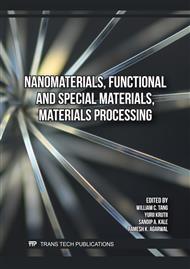[1]
Shufi, R. H., Ranap, P., and Naibaho, T. (2023). "Case study: Use of dry mix concrete as a substitute material for ready mix concrete on development projects OCC Building – Jabodebek LRT Depot." Jurnal Syntax Admiration, 4(4), 456-466.
DOI: 10.46799/jsa.v4i4.577
Google Scholar
[2]
Jaiswal, A., Singh, T., Jha, A., and Ankita, M. (2023). "Assessing quality in ready-mix concrete production: A case study of B. L. Kashyap and Sons Ltd." Review of Professional Management, 21(2).
DOI: 10.1177/09728686231189028
Google Scholar
[3]
Vikas, G., and Rao, T. D. G. (2021). "Setting time, workability, and strength properties of alkali-activated fly ash and slag-based geopolymer concrete activated with high silica modulus water glass." Iranian Journal of Science and Technology - Transactions of Civil Engineering, 45(6), 1483–1492.
DOI: 10.1007/s40996-021-00598-8
Google Scholar
[4]
Oni, O., and Arum, C. (2023). "Workability and compressive strength of concrete containing binary cement, mixed fines, and superplasticizer." Facta Universitatis - Series: Architecture and Civil Engineering, 21(2), 299–314.
DOI: 10.2298/FUACE220818017O
Google Scholar
[5]
Xingdong, L., Beixing, L., Yan, S., and Huaquan, Y. (2015). "Comparison of the influence of amino trimethylene phosphonic acid and sodium gluconate on the performance of concrete." Proceedings of the 2015 International Conference on Architectural, Civil and Hydraulics Engineering, Atlantis Press, 1-8.
DOI: 10.2991/icache-15.2015.1
Google Scholar
[6]
Palaniappan, M., Murugan, K., Gurusamy, A., et al. (2024). "Arriving at the optimum retarder dosage level of sugar on the setting time, compressive strength, and microstructure property of Portland pozzolana cement." International Review of Applied Sciences and Engineering.
DOI: 10.1556/1848.2024.00753
Google Scholar
[7]
Gharehgheshlagh, H. H., Chehreghani, S., and Seyyedi, B. (2023). "Effects of various grinding aids dosage on comminution efficiency and cement characteristics." Rudarsko Geolosko Naftni Zbornik, 38(1), 69–82.
DOI: 10.17794/rgn.2023.1.7
Google Scholar
[8]
Kumar, B. A., and Begum, S. (2021). "An experimental investigation on the influence of nano silica on the strength and durability characteristics of self-compacting concrete." International Journal of Science Research Science Technology, 8(4), 598–605.
DOI: 10.32628/IJSRST218494
Google Scholar
[9]
Yu, B., Moumin, M., and Plank, J. (2018). "PCE superplasticizers used as dispersants in oil well cementing." Proceedings of the Twelfth International Conference on Superplasticizers and Other Chemical Admixtures in Concrete, Beijing, China. Atlantis Press.
DOI: 10.14359/51711203
Google Scholar
[10]
Reddy, K. S. K., Rafi, D. M., and Dadapeer, A. B. S. (2020). "An experimental study on the influence of nano silica on the strength and durability characteristics of self-compacting concrete." International Journal of Science Research Science Technology, 7(5), 295–302.
DOI: 10.32628/IJSRST207559
Google Scholar
[11]
Kavipriya, K., Rajendran, S., Sathiyabama, J., and Suriya Prabha, A. (2012). "A critical review of corrosion inhibition by phosphonic acids." European ChemicalBulletin, 1(9), 366-374.
Google Scholar
[12]
Zhou, B., Zhang, M., Zhang, J., and Wei, J. (2024). "Microstructure and phase characterization of alkali-activated slag–fly ash materials with tetrasodium of 1-hydroxy ethylidene-1, 1-diphosphonic acid (HEDP·4Na)." Buildings, 14(5), 1383.
DOI: 10.3390/buildings14051383
Google Scholar
[13]
Choi, Y. C., Cho, Y. K., Shin, K. J., and Kwon, S. J. (2016). "Development and application of microcapsule for cement hydration control." KSCE Journal of Civil Engineering, 20(1), 282–292.
DOI: 10.1007/s12205-015-0281-8
Google Scholar
[14]
Chen, J., Li, R., Thienel, K., and Plank, J. (2023). "PCE superplasticizers for calcined clay blended cements – challenges and solutions." CE/Papers, 6(3), 425–430.
DOI: 10.1002/cepa.2784
Google Scholar
[15]
Cement and Concrete Sectional Committee, CED 2. (2015). Composite Cement - Specification, IS 16415:2015. Bureau of Indian Standards, New Delhi, India.
Google Scholar
[16]
Bureau of Indian Standards. (1987). IS 12269: Specification for 53 Grade Ordinary Portland Cement. Bureau of Indian Standards, New Delhi, India.
Google Scholar
[17]
Bureau of Indian Standards. (2016). IS 383: Specification for Coarse and Fine Aggregates from Natural Sources for Concrete. Bureau of Indian Standards, New Delhi, India.
Google Scholar
[18]
Bureau of Indian Standards. (2019). IS 10262: Concrete Mix Proportioning - Guidelines (Second Revision). Bureau of Indian Standards, New Delhi, India.
Google Scholar
[19]
Bureau of Indian Standards. (1959). IS 1199: Methods of Sampling and Analysis of Concrete. Bureau of Indian Standards, New Delhi, India.
Google Scholar
[20]
Bureau of Indian Standards. (2000). IS 456: Plain and Reinforced Concrete - Code of Practice. Bureau of Indian Standards, New Delhi, India.
Google Scholar
[21]
Bureau of Indian Standards. (1959). IS 516: Methods of Tests for Strength of Concrete. Bureau of Indian Standards, New Delhi, India.
Google Scholar
[22]
ASTM International. (2020). ASTM C231/C231M-17a: Standard Test Method for Air Content of Freshly Mixed Concrete by the Pressure Method. ASTM International, West Conshohocken, PA.
Google Scholar
[23]
Ley, T., Fick, G., and Cook, D. (2024). Impact of Concrete Placing Method on Air Content, Air Void System Parameters, and Freeze-Thaw Durability. American Concrete Institute (ACI) Special Publication, SP-349. American Concrete Institute, Farmington Hills, MI.
DOI: 10.14359/51711204
Google Scholar
[24]
American Association of State Highway and Transportation Officials (AASHTO). (2024). AASHTO T 152: Standard Method of Test for Air Content of Freshly Mixed Concrete by the Pressure Method. AASHTO, Washington, D.C.
DOI: 10.1520/C0231_C0231M-17a
Google Scholar
[25]
ASTM International. (2017). ASTM C232/C232M-17: Standard Test Method for Bleeding of Concrete. ASTM International, West Conshohocken, PA. https://doi.org/10.1520/ C0232_C0232M-17.
Google Scholar
[26]
American Concrete Institute (ACI). (2008). ACI 304.2R-96: Placing Concrete by Pumping Methods. American Concrete Institute, Farmington Hills, MI.
DOI: 10.14359/1041
Google Scholar
[27]
Ma, S., Li, W., Zhang, S., et al. (2015). "Influence of sodium gluconate on the performance and hydration of Portland cement." Construction and Building Materials, 91,138–144.
DOI: 10.1016/j.conbuildmat.2015.05.068
Google Scholar
[28]
Badban, S. (2017). Adsorption and Ionization of Carboxylic Acids at the Air/Water Interface. Journal of Physical Chemistry C, 121(50), 28088–28097. American Chemical Society, Washington, D.C.
Google Scholar
[29]
Bureau of Indian Standards. (1984). IS 2185-3: Concrete Masonry Units, Part 3: Autoclaved Cellular Aerated Concrete Blocks. Bureau of Indian Standards, New Delhi, India.
DOI: 10.6028/nbs.tibm.23
Google Scholar


